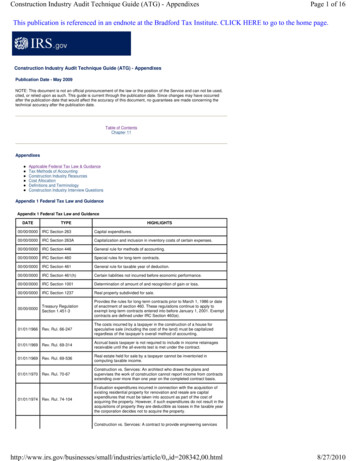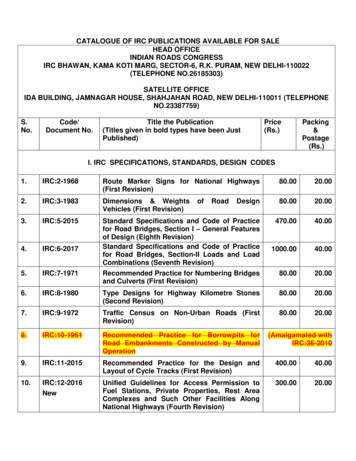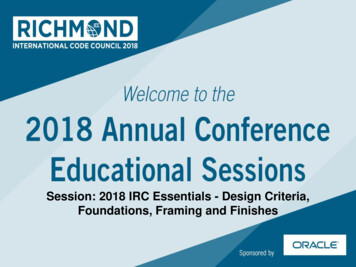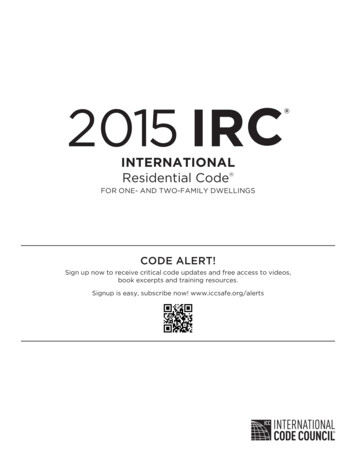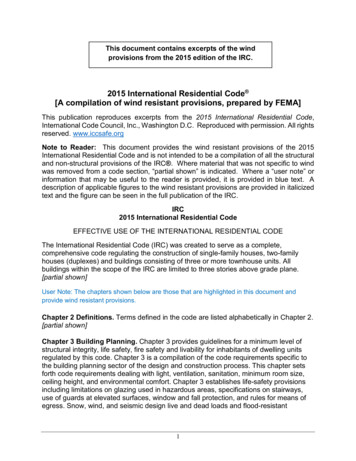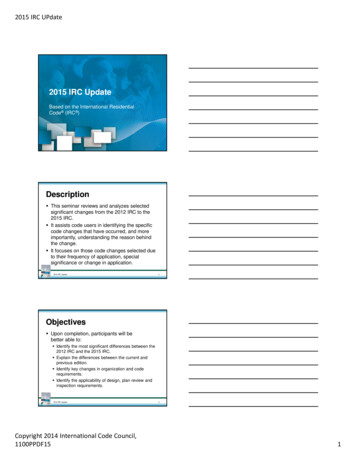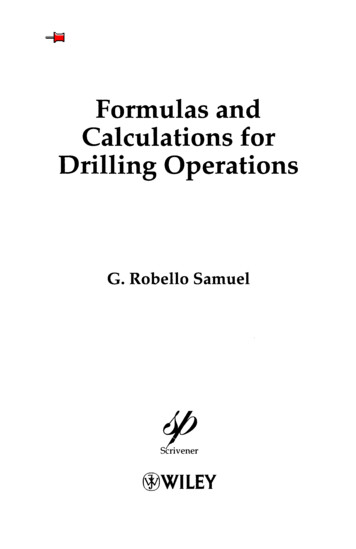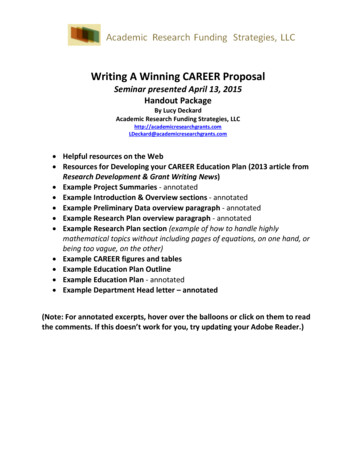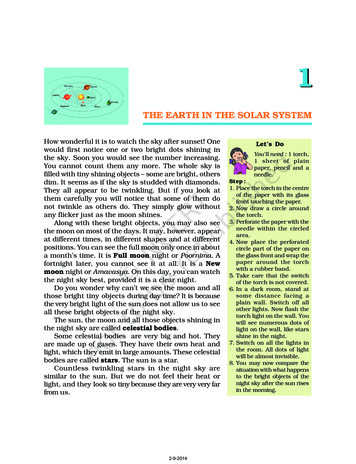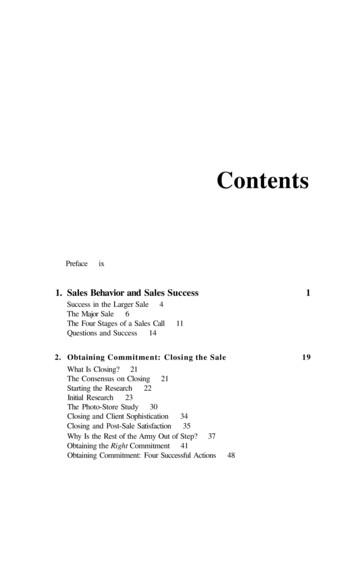
Transcription
Presenting a live 90-minute webinar with interactive Q&AIRC Section 355 Corporate Spin-OffTransactions: Optimizing TaxTreatment in DivestituresWEDNESDAY, MARCH 30, 20161pm Eastern 12pm Central 11am Mountain 10am PacificToday’s faculty features:Jessica A. Hough, Partner, Skadden Arps Slate Meagher & Flom, Washington, D.C.Scott M. Levine, Partner, Jones Day, Washington, D.C.Elizabeth M. Norman, Partner, Nutter McClennen & Fish, BostonThe audio portion of the conference may be accessed via the telephone or by using your computer'sspeakers. Please refer to the instructions emailed to registrants for additional information. If youhave any questions, please contact Customer Service at 1-800-926-7926 ext. 10.NOTE: If you are seeking CPE credit, you must listen via your computer — phone listening is nolonger permitted.
Tips for Optimal QualityFOR LIVE EVENT ONLYSound QualityIf you are listening via your computer speakers, please note that the qualityof your sound will vary depending on the speed and quality of your internet connection.If the sound quality is not satisfactory, you may listen via the phone: dial1-866-328-9525 and enter your PIN when prompted. Otherwise, pleasesend us a chat or e-mail sound@straffordpub.com immediately so we can address theproblem.If you dialed in and have any difficulties during the call, press *0 for assistance.NOTE: If you are seeking CPE credit, you must listen via your computer — phonelistening is no longer permitted.Viewing QualityTo maximize your screen, press the F11 key on your keyboard. To exit full screen,press the F11 key again.
Continuing Education CreditsFOR LIVE EVENT ONLYIn order for us to process your continuing education credit, you must confirm yourparticipation in this webinar by completing and submitting the AttendanceAffirmation/Evaluation after the webinar.A link to the Attendance Affirmation/Evaluation will be in the thank you email that youwill receive immediately following the program.For CPE credits, attendees must participate until the end of the Q&A session andrespond to five prompts during the program plus a single verification code. In addition,you must confirm your participation by completing and submitting an AttendanceAffirmation/Evaluation after the webinar and include the final verification code on theAffirmation of Attendance portion of the form.For additional information about continuing education, call us at 1-800-926-7926 ext.35.
Background of Relevant Section 355Provisions4
Section 355 Requirements Statutory Requirements Control Immediately Before Distribution of Stock and Securities Constituting Control Not a Device for Distribution of E&P Distributing & Controlled Engaged in an Active Trade or Business Section 355(g) Section 355(a) Non-statutory Requirements Business Purpose Continuity of Shareholder Interest Continuity of Business Enterprise Special Corporate-Level Requirements Section 355(d) and (e)5
No Device Requirement The distribution cannot be used principally as a device for the distributionof the earnings and profits (“E&P”) of either D or C. Seeks to prohibit bail-out of a corporation’s E&P at capital gains rates. Device factors (Treas. Reg. section 1.355-2(d)(2)) Pro-rata distribution Sale or exchange of D or C after distribution- A sale or exchange of D or C stock pursuant to an arrangement negotiated or agreedupon prior to the distribution is substantial evidence of device D or C has excessive non-business assets Non-Device factors (Treas. Reg. section 1.355-2(d)(3)) Corporate business purpose D is publicly traded and no 5% shareholder All distributee corporations entitled to DRD6
Treas. Reg. Section 1.355-2(d)(5)(iv)Section 302(a) Transactions Treas. Reg. Section 1.355-2(d)(5)(iv)–A distribution is ordinarily considered not to have been used principally as a device if, in the absenceof section 355, with respect to each shareholder distributee, the distribution would be a redemption towhich section 302(a) applied.–Treas. Reg. section 1.355-2(d)(5)(i) provides that such distributions are ordinarily considered not tohave been used principally as a device, notwithstanding the presence of any of the device factorsdescribed in Treas. Reg. section 1.355-2(d)(2).–Treas. Reg. section 1.355-2(d)(5)(i) “ordinarily” protection is not available if the same shareholder(s)receive more than one C in a split off and then one or more C is retained while one or more C is sold(the “Exception”). See also Treas. Reg. section 1.355-2(d)(5)(v), Ex. 2. Exception presumably concerned with economically similar transaction where D splits off Cwhere C has 2 or more businesses and then C contributes a business to C1 and spins off C1 prorata to the shareholders split off from D. What does “ordinarily” mean? Is the exception to such language limited to the Exception? Isthe allocation of E&P under Treas. Reg. section 1.312-10 evidence of device because itpotentially enables future distributions to result in a smaller dividend?7
Device (Cont’d): Nature & Use of AssetsTreas. Reg. Section 1.355-2(d)(2)(iv) General Rule– The determination of whether a transaction was used principally as a devicewill take into account the nature, kind, amount, and use of the assets of D andC (and corporations controlled by them) immediately after the transaction. Non-Qualifying Assets– The existence of assets that are not used in a trade or business that satisfies theATB requirement (“Non-Qualifying Assets”) is evidence of device.– Examples include cash and other liquid assets that are not related to thereasonable needs of the ATB. The higher the ratio for each corporation of the value of Non-QualifyingAssets not used to the value of ATB-qualifying assets, the more evidence ofdevice. In a split off, liquid assets used to equalize values ordinarily is not evidenceof device.8
Device (Cont’d):Treas. Reg. Section 1.355-2(d)(4), Ex. 4 Background: Corporation X is engaged in a regulated business inState M and owns all of the stock of corporation Y, which is notengaged in a regulated business in State M. State M has recentlyamended its laws to provide that affiliated corporations operating inM may not conduct both regulated and unregulated businesses. X purchases operating assets unrelated to the Y business andtransfers them to Y. X then distributes the Y stock pro rata amongX’s shareholders. As a result of the transfer of the recently acquired operating assets,the ratio of the value of its Non-Qualifying Assets to the value of itsATB-qualifying assets is substantially greater for Y than for X. There is no other evidence of device or evidence of nondevice. Conclusion: The transaction is considered to have been usedprincipally as a device.9
Relevance of Business Purpose to No DeviceRequirement: Treas. Reg. Section 1.355-2(d)(3)(ii) The corporate business purpose for the transaction is evidence ofnondevice. The stronger the evidence of device, the stronger the corporate businesspurpose required to satisfy the no device requirement. The transfer or retention of Non-Qualifying Assets can be outweighed bythe existence of a corporate business purpose for such transfers orretentions. Strength of a corporate business purpose will be based on all of facts andcircumstances, including, but not limited to, the following factors:– The importance of achieving the purpose to the success of the business;– The extent to which the transaction is prompted by a person not having aproprietary interest in D or C, or by other outside factors beyond the control ofthe D; and– The immediacy of the conditions prompting the transaction.10
Section 355(g) Section 355 will not apply if:(A) Immediately after the transaction, either D or C is a Disqualified Investment Corporation(“DIC”), and(B) Immediately after the transaction, any person owns a 50 percent (vote or value, applyingsection 318 attribution) or greater interest in any DIC, but only if such person did nothold such an interest in such corporation immediately before the transaction. D or C is a DIC if 2/3 or more of the FMV of all of its assets constitutes investmentassets. “Investment Assets” include: Cash, stock or securities, certain partnership interests, debt, options, forward or futurescontract, notional principal contract, derivative, foreign currency, or any similar asset. Look-through rule when ownership of at least 20% of the vote and value in lower-tiercorporate subsidiaries. Exception for certain assets used in financial trade or business, certain mark-to-marketassets.11
Active Trade or Business Requirement(1) D and C must each be engaged in an active trade or business (“ATB”) immediatelyafter the distribution.(2) Both D and C’s business must have been actively conducted throughout the 5-yearperiod ending on the date of the distribution.(3) Neither D nor C’s business (nor control of a corporation conducting such business)can have been acquired in a taxable transaction within 5-years of the distribution.Note: The ATB test was inserted in order to prevent the tax free separation of anexisting corporation into active and inactive entities. S. Rept. No. 1622, 83d Cong.,2d Sess. 51 (1954).Enactment of Section 355(b)(3): Starting in 2006, all members of a corporation’s“separate affiliated group” (i.e., the affiliated group that would be determined undersection 1504(a) if such corporation were the common parent and section 1504(b)did not apply)—determined immediately after the distribution—generally aretreated as a single corporation for purposes of the ATB requirement.12
Size of D’s and C’s ATB Relative to Other Assets Section 355(b) and Treas. Reg. section 1.355-3(b) No specific reference to absolute or relative size of the ATB. Rev. Rul. 73-44 General Counsel Memoranda relating to size of active trade or business.13
Overview ofRev. Proc. 2015-43& Notice 2015-5914
Rev. Proc. 2015-43 & Notice 2015-59 IRS releases Rev. Proc, 2015-43 and Notice 2015-59 (the “Notice”) on September 14, 2015. If guidance contemplated by the Notice is issued, would such guidance be retroactive to the date ofthe Notice? Rev. Proc. 2015-43 provides 3 no-rule policies under section 355 and related provisions forspin-offs involving relatively small ATBs or REIT/RIC conversions. The Notice states that Rev. Proc. 2015-43 does not distinguish between pro rata and non-pro ratadistributions. See Slide 21 for a more detailed discussion. Rev. Proc. 2015-43 supplements Rev. Proc. 2015-3, and applies to all ruling requests that arepostmarked (or, if not mailed, received) on or after September 14, 2015 that relate to spin offsoccurring after such date. Rev. Proc. 2015-43 provides that the IRS will not issue a ruling on “any issue relating to thequalification under section 355 and related provisions” if one of the three no-rule policies applies. What is the scope of this statement? Are section 355(d) and (e) issues considered “qualification” issues?15
Rev. Proc. 2015-43 & Notice 2015-59 Notice 2015-59 (the “Notice”) identifies four circumstances in whichqualification of a distribution under section 355 is under study:1.Ownership by D or C of a small amount of ATB Assets in relation to all ofits assets.2.Ownership by D or C of investment assets having substantial value inrelation to (a) the value of all of such corporation’s assets, and (b) the valueof the assets of the trade(s) or business(es) relied upon to meet the ATBrequirement (“ATB Assets”).3.A significant difference between D’s ratio of investment assets to assetsother than investment assets and such ratio of C.4.An election by D or C (but not both) to be a RIC or a REIT.16
Relevance of General Utilities Repeal toDevice and ATB Requirements Treasury and the IRS reference sections 337(d) and 355 when discussing the four circumstances under study. Section 337(d) provides: The Secretary shall prescribe such regulations as may be necessary or appropriate to carry out the purposes of the amendmentsmade by subtitle D of title VI of the Tax Reform Act of 1986, including—(1) regulations to ensure that such purposes may notbe circumvented through the use of any provision of law or regulations (including the consolidated return regulations and partIII of this subchapter) or through the use of a regulated investment company, real estate investment trust, or tax-exempt entity,and (2) regulations providing for appropriate coordination of the provisions of this section with the provisions of this titlerelating to taxation of foreign corporations and their shareholders. The preamble to the 1989 final device regulations provided that “[the IRS] is developing regulations under section 337(d) ofthe Code that will relate to the distribution of stock, or stock and securities, of a controlled corporation. New section 1.3556 is reserved for this purpose.” In March, 1989, Treasury indicated that it would be exercising its authority under section 337(d) to prevent the use of“subsidiary-tracking” stock to sell a business without triggering a General Utilities tax. The scheme, as explained byTreasury, was the purchase by X of D stock tracking C eventually followed by a split off of C to X. In 1990, Congress enacted section 355(d), effectively shutting down the transaction described immediately above. In 1992, Treasury closed the regulatory project reserved for under Treas. Reg. section 1.355-6 without the promulgation ofregulations. Rev. Rul. 2003-110 (holding that “[i]n determining whether a distribution of the stock of a controlled corporation satisfiesthe [business purpose requirement] that the distribution be motivated, in whole or substantial part, by one or more corporatebusiness purposes, the fact that [section] 355 permits [D] to distribute the stock of [C] without recognition of gain does notpresent a potential for the avoidance of Federal taxes under [Treas. Reg. section] 1.355-2(b).”). Does the reference to section 337(d) relate to all of the no rules in Rev. Proc. 2015-43 or only the Opco/Propco no rule? 17
Small ATB No-Rule 1 Section 3.01 of Rev. Proc. 2015-43 and Section 4.01(58) of Rev. Proc. 2015-3. IRS ordinarily will not rule on any issue relating to qualification under section 355 where,immediately after the distribution, the FMV of the gross ATB Assets of D or C is less than 5percent of the total FMV of the gross assets of such corporation. Is Rev. Rul. 73-44 still good law? What relevance do the GCMs relating to the underlying analysisof Rev. Rul. 73-44 have on the IRS’s current thinking? Is a ruling request submitted prior to September 14, 2015 still eligible to receive an ATB size ruling? Will the IRS still rule on ATB if the taxpayer is able to make the 5% representation but the ratio ofinvestment assets to Qualifying Assets is high? The Notice states that granting tax-free treatment to a distribution involving a small ATB hasbecome less justifiable since the enactment of section 355(b)(3), and that IRS will onlyconsider ruling requests involving small ATBs in unique and compelling circumstances. Relevant facts include: (i) the presence of assets that would be ATB Assets but for the fiveyear requirement of section 355(b)(2)(B), and (ii) a relationship between the business purposefor the distribution and the Qualifying Assets of D or C.18
Small ATB No-Rule 2 Section 4.01 of Rev. Proc. 2015-43 and Section 5.01(26) of Rev. Proc. 2015-3. IRS will not rule (until resolved by Revenue Ruling, Revenue Procedure, Regulations or otherwise) onany issue relating to the qualification under section 355 of a distribution where, immediately after thedistribution, all of the following conditions exist: (i) The FMV of the investment assets of D or C is two-thirds or more of the total FMV of itsgross assets; (ii) The FMV of the gross ATB Assets of D or C is less than 10 percent of the FMV of itsinvestment assets; and (iii) the ratio of the FMV of the investment assets to the FMV of the assets other than investmentassets of D or C is three times or more of such ratio for the other corporation. Does the same entity (D or C, as the case may be) have to satisfy all 3 requirements above for the norule to apply? Must taxpayers now provide a representation as to each of these three tests when submitting rulingrequests? With respect to prong (iii) above, is the relevant inquiry FMV of gross or net assets?19
Small ATB No-Rule 2Anti-Abuse Rule Section 5.01(26) of Rev. Proc. 2015-43 provides that the IRS will not rule (untilresolved by Revenue Ruling, Revenue Procedure, Regulations or otherwise) onany issue relating to the qualification under section 355 of a distribution where,as part of a plan or series of related transactions:1. Investment assets are disposed of, or2. Non-investment assets (including ATB Assets) are acquiredwith a principal purpose of avoiding Small ATB No-Rule 2. Assume taxpayer is considering transferring either small ATB1 or big ATB2 intoC. Is the anti-abuse rule tripped if taxpayer transfers big ATB2 with a principalpurpose of avoiding Small ATB No-Rule 2?20
Small ATB No-Rules: Special Rules & Definitions For purposes of determining the FMV of the gross assets and gross ATB Assets of acorporation, (i) all members of a separate affiliated group (“SAG”) are treated as onecorporation, and (ii) if D or C relies on the ATB of a partnership, it is treated as owning its ratableshare of the gross assets of the partnership.The term “investment assets” is the same as defined in section 355(g)(2)(B) (e.g., cash,stock, debt), except that with respect to publicly traded stock and interests in publiclytraded partnerships, the look-through rule in section 355(g)(2)(B)(iv) is applied byrequiring 50 percent (vote and value) ownership. The section 355(g)(2)(B) definition of “investment assets” does not include realproperty. Is real property excluded for purposes of the no-rule?Why did the IRS increase the requisite ownership interest for look-through treatmentfrom the 20% threshold under section 355(g)(2)(B)(iv) to 50%? Did Congress alreadytell us what constitutes investment assets for purposes of section 355 upon the enactmentof section 355(g)?21
Recent Ruling History with Small ATBs PLR 201435005: D spun off C, the principal assets of which were a significant stake (albeitless than 80%) in a publicly traded company and business assets satisfying the ATBrequirement. D received a PLR that the spin-off will qualify for tax-free treatment (no rulingson device, business purpose or 355(e)). PLR 201535007: Key Ruling: “Provided that Business A otherwise satisfies therequirements of section 355(b), the size of Business A will not preclude Newco TRS,Controlled 1 and Distributing from satisfying the active trade or business requirement ofsection 355(b) .” PLR 201531014: Key Ruling: “[T]he relative fair market value of the gross assets ofBusiness A1a (as compared to the fair market value of all gross assets of Controlled 1), andthe relative fair market value of the gross assets of Business B1 formerly held directly byFSub 2 (as compared to the fair market value of all gross assets of Distributing 3 orDistributing 2, as applicable), will not prevent Business A1a or Business B1 from qualifyingas an active trade or business for purposes of section 355(b).” A taxpayer recently publicly announced that IRS refused to issue it a ruling on a request filedprior to release of Rev. Proc. 2015-43/Notice 2015-59 with respect to a transaction in which Dwould contribute ATB and a minority interest in a publicly-traded corporation to newlyformed C followed by the pro rata distribution of C to D’s public shareholders. ATBrepresented an extremely small percentage of C’s total assets.22
Small ATB No-Rules:Exception for Certain Internal Distributions Neither Small ATB No-Rule 1 nor Small ATB No-Rule 2 apply to an internaldistribution (i.e., C stock is distributed to one or more members of the affiliatedgroup of which D is a member), provided it is not part of a plan or series oftransactions in which there is an external distribution that is described in Sections4.01(57), 4.01(58), or 5.01(26) of Rev. Proc. 2015-3, as supplemented by Rev.Proc. 2015-43. Section 243(b)(2)(A): “The term “affiliated group” has the meaning given such termby section 1504(a), except that for such purposes sections 1504(b)(2), 1504(b)(4), and1504(c) shall not apply.” 1504(b)(2) refers to insurance companies. 1504(b)(4) refers to “corporations with respect to which an election under section 936(relating to possession tax credit) is in effect for the taxable year.” Can taxpayers obtain a private letter ruling for lower-tier spins involvingrelatively small ATBs?23
Pro Rata Distributions and Non-Pro RataExchanges of Stock Treated Similarly In referencing split offs where the exchanging shareholders would be afforded section 302(a)treatment, the IRS stated that “[o]bviously where the transaction cannot possibly be used as adevice for the distribution of earnings and profits so that there is no possibility that the[C]ongressional policy behind section 355 can be frustrated, the percentage of ‘active’ assets,assuming literal compliance with the statute, is of minor importance.” G.C.M. 34238 (Dec. 15,1969). Similarly, in G.C.M. 31959 (Apr. 7, 1961), the IRS concluded that “[s]ince the device prohibitionseems to have been intended to prevent the distribution of earnings, we do not believe atransaction can be a device within the meaning of section 355(a)(1)(B) if the taxpayer couldobtain capital gain treatment without resort to section 355.” IRS notes that section 355(g) will not apply to most split offs involving publicly tradedcorporations “because no single shareholder or group of related shareholders will own more than50 percent of the stock of either [D] or [C] after the distribution.” Treasury and IRS believe that a public split off transaction where the exchanging shareholders areafforded section 302(a) treatment can still fail the device requirement where the asset mix issimilar to the asset mixes described in Rev. Proc. 2015-43 and Notice 2015-9. What is the IRS’s current view as to what the device requirement is policing? Does the IRSbelieve the device requirement’s mandate was expanded upon the repeal of the General UtilitiesDoctrine and the enactment of section 337(d)?24
Business PurposeRequirement25
Business Purpose RequirementTreas. Reg. section 1.355-2(b) Corporate business purpose – The distribution must be carried out for one or more corporatebusiness purposes. The transaction must be motivated, in whole or substantial part, by suchcorporate purposes. Exigency – Provide nonrecognition only to distributions incident to readjustments ofcorporate structure required by business exigency. Other than federal income tax avoidance – Must be a real and substantial non-federal taxpurpose germane to the business of D, C or D’s affiliated group. No impractical or unduly expensive nontaxable alternative. Rev. Proc. 96-30 contains a non-exhaustive list of IRS-approved corporate business purposes,though the IRS stopped issuing private letter rulings on the business purpose requirement in2003.– Business purposes described in Rev. Proc. 96-30 include enhancing the fit and focus of each business,providing an equity interest in a particular business to a key employee, facilitating a borrowing orstock offering, facilitating an acquisition by D or C (or of D), producing cost savings, and eliminatingcompetition with customers or suppliers.Does there need to be an independent, corporate business purpose for contributing the reliedupon ATB to C (or holding back the relied upon ATB in D)?26
Business Purpose Requirement and IRS RulingPolicy IRS no longer grants PLRs confirming that specific business purposes are sufficient forpurposes of section 355. However, prior to 2003, the IRS did grant such rulings.Past PLRs that have been published give some indication of the types of business purposesthat are considered sufficient to satisfy this requirement. Such purposes include (this is not anexclusive list):–––––– fit and focus (concentrating the activities of a single entity on a single business or group ofbusinesses)risk reduction (segregating businesses with more risks away from other businesses)facilitation of an acquisition by separating wanted and unwanted assetscompensation of employees through stock ownership plans tied to specific businessesraising capitalcost savingsThe business purpose does not have to be one of those listed, but does have to be real andsupported by facts.Post‐spin facts and business arrangements can be relevant for business purpose. The level ofoverlap and interaction between D and C can undermine the business purpose. Sometransition period (2 years) moving towards an ultimate separation is generally okay, but longerperiods of continued relationships and/or shared services can raise issues.27
Specific Business Purposes Provide equity interest to key employee - “significant amount” (Rev. Rul.69-460, Rev. Rul. 88-34, Rev. Rul. 85-127) Facilitate post-distribution stock offering (Rev. Rul. 2003-55)Investment banker letter Cost savings Facilitate borrowing (Rev. Rul. 2003-75, Rev. Rul. 77-22)Demonstrate able to borrow more money or borrow with better terms28
Specific Business Purposes (Cont’d) Fit and focus – enhance success of D and C by enabling corporations toresolve management, systemic, and/or other problems (Rev. Rul. 2003-74;2003-75) Friction with customers/suppliers regarding competition (Rev. Rul.2003-110) Acquisition of D (Rev. Rul. 2003-79)Deal in place - 355(e)! Acquisition by D or CDeal in place -- 355(e)! Increase stock price of public company (Rev. Rul. 2004-23)Still need to show corporate-level benefit such as intended use ofstock as acquisition currency or to hire/retain key employees.29
Specific Business Purposes (Cont’d) Separate risky and non-risky businessesMust be able to answer why not accomplished by forming a holdingcompany structure or securing adequate insurance State or foreign tax savings (Rev. Rul. 76-187; Rev. Rul. 89-101)But see Treas. Reg. section 1.355-2(b)(2) Shareholder disputes/going own way (Rev. Rul. 2003-52) Regulatory problems (Rev. Rul. 88-33) Labor problems Expropriation fears Required divestiture (Rev. Rul. 83-23)Rev. Proc. 96-30, Appendix A30
Pre & Post Spin TransactionsIntent of restrictions: to avoid providing preferentialtax treatment to transactions that resemblecorporate-level sales.Result: spin-off coupled with a tax-free or taxableacquisition will cause parent to be taxed on anycorporate level gain in the spin-off company’s stock,if as part of the plan (or series of relatedtransactions) encompassing the spinoff, one or morepersons acquires a 50% or greater interest in theparent or the spinoff company.31
Pre & Post Spin TransactionsPresumption of Plan Acquisitions occurring either within the two yearsbefore or within the two years after the spinoff arepresumed to be part of a plan or series of relatedtransactions with the spinoff. 50% or greater threshold – combined voting poweror combined value. IRS regulations include facts and circumstancestests and safe harbors for determining whether anacquisition and spinoff are part of a plan or seriesof related transactions.32
Pre-Spin TransactionsRebuttable PresumptionGenerally, where there have been no “substantialnegotiations” with respect to the acquisition of theparent or the spinoff company or a “similaracquisition” within two years prior to the spin-off, anacquisition of the parent or the spin-off companyfor acquirer stock after the spinoff will notjeopardize the tax-free nature of the spin-off.33
Pre-Spin TransactionsSubstantial Negotiations Generally require discussions of significanteconomic terms. An actual acquisition is generally “similar” toanother potential acquisition if the actualacquisition affects a direct or indirect combinationof all or a significant portion of the same businessassets as the potential acquisition would have.34
Post-Spin TransactionsSection 355(e) Rules: “anti-Morris Trust” rules Spin-off taxable at the corporate level (although notat the shareholder level) if the spin-off is a part of a“plan” that includes the acquisition of 50% of thevote or value of the parent or the spin-off company.35
Post-Spin TransactionsWhat do the regulations say? Post-spin equity transactions that are part of the plan remainviable where the historic shareholders of the parent retain agreater than 50% interest (by vote and value) in the parent andthe spin-off company after the merger transaction. A spin-off followed by a merger with a smaller company isfeasible even if it is part of a plan or series of relatedtransactions with the spinoff and has been in the format of anumber of significant recent transactions. If the merger partner is larger than the parent or spinoffcompany to be acquired, it may be possible to have themerger partner borrow funds to redeem or otherwise shrink itscapitalization prior to the merger transaction.36
Post-Spin TransactionsWhat do the regulations say?Acquisition not deemed to be part of spin-off if:1) No agreement regarding acquisition within thetwo-year period ending on the date of thecompletion of the spin-off; OR2) Spin-off motivated in whole or substantial part by acorporate business purpose and no agreement,regarding the acquisition during the period thatbegins one year before the spin-off and ends sixmonths after the completion of the spin-off; OR3) No agreement at time of spin-off AND noagreement within one year after the completion ofthe spin-off.37
Post-Spin TransactionsTwo Year Period Prior to Spin-off: Agreement includes understanding, arrangementor “substantial negotiations” regarding acquisition Includes “similar acquisitions” Two-year period ends on date of the completion ofthe spin-off38
Post-Spin TransactionsOne Year
Mar 30, 2016 · spin-offs involving relatively small ATBs or REIT/RIC conversions. The Notice states that Rev. Proc. 2015-43 does not distinguish between pro rata and non-pro rata distributions. See Slide 21 for a more detailed discussion. Rev. Proc. 2015-43 supplements Rev.
